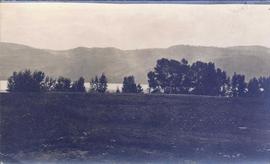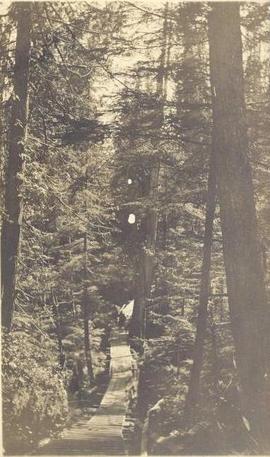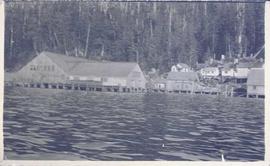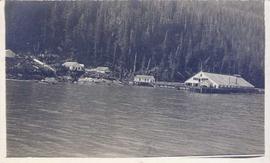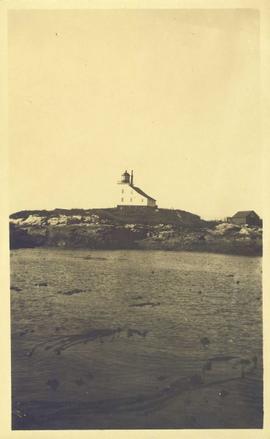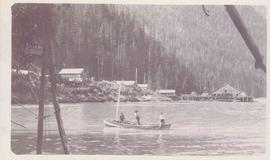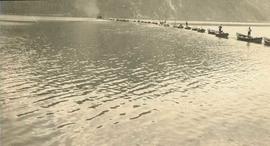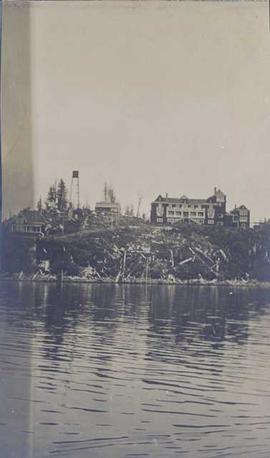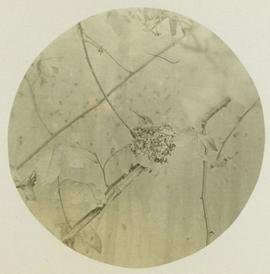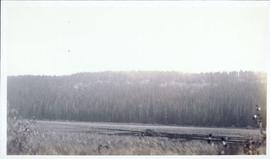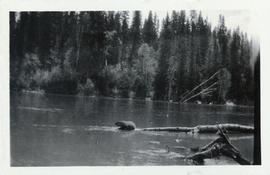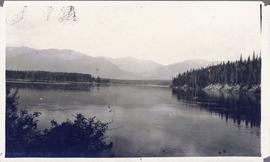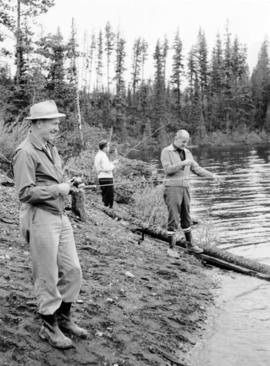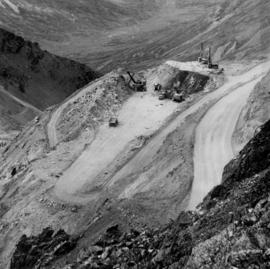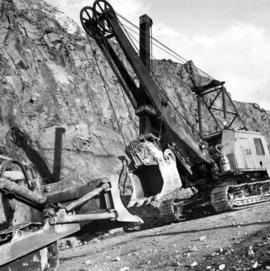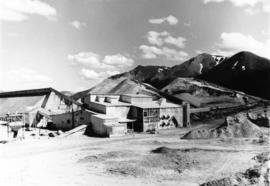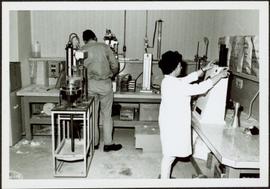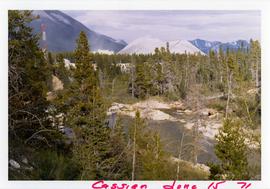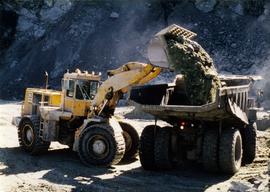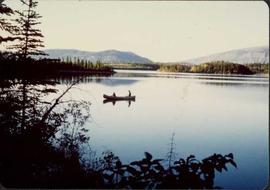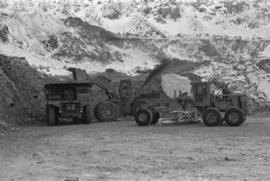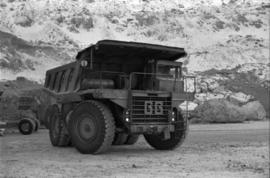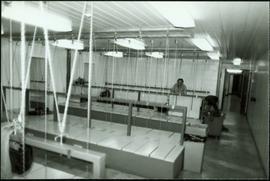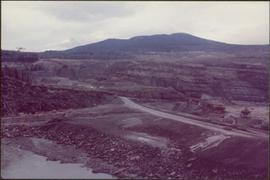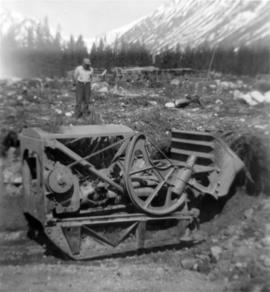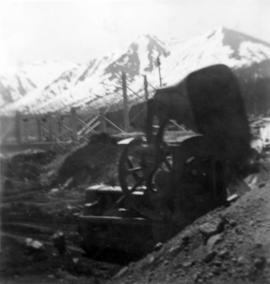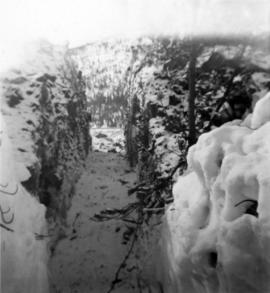Footage of Robson feeding his deer. The location of the filming is believed to be Robson's home in Bella Coola.
Black bear on the shore of a river. The location is unknown.
Footage of golden eye duck and ducklings on a lake.
Speculated locations include Anahim Lake, Ulkatcho Lake or Fenton Lake.
Footage of a large nest in a tree, possibly an Eagle or a Osprey nest, with baby birds within.
Footage of porpoise swimming in front of boat. Footage of swallow in tree.
Location is unknown, but most likely on the coast of British Columbia.
Footage of a moose hunt, moose kill, and butchering of the moose.
Possible locations of this footage are the Chilcotin region, Rainbow Mountains or Tweedsmuir Provincial Park.
Footage of horses in corral.
Location is believed to be Holt Homestead or Lassard Lake.
Footage of Bighorn Sheep in the winter.
The location of filming is unknown.
Footage of large animal, most likely a moose, along a steep bank. Two men and their pack horse traveling along an open landscape, a close shot of their campfire at night, then footage of them preparing for a journey early in the morning. Also a view of a herd of caribou, the men traveling in a pack train over a stream and through upper valleys of the mountains, various sunset shots, a lake full of birds feeding, and finally the men packing the horses with killed game meat, most likely caribou.
The location of the filming is most likely the Rainbow Mountains.
Footage includes salmon jumping in a river, men filleting fish in fishing boat in tide water, a beaver in the water, and a bird, probably a heron, flying.
Recordings from the boat on a river, some loons on a lake, either Anahim or Fenton lake, and a panoramic view of the lake with mountains in background.
Also some footage of men fishing from the shore of a river, children catching fish, children swimming, some river rapids, footage of an eagle, a pelican on the lake, a group of birds, probably sand pipers, in water.
There are two young girls playing on a boat near shore, a view of white and brown house, and an older boy pulling a young girl in a wagon.
Include is footage of a backyard BBQ picnic, two young girls fishing, a cabin at a lake, and general scenery of birch trees, a boat house, and a dock at lake.
There is also a sign that reads "Breezy Cove," people relaxing on porch in front of cabin, and footage of a woman believed to be Mrs. Elsey and a friend walking on a forest path.
The film ends with footage of more fishing off a motor boat and unloading the motor boat at a dock.
Possible locations of the filming include the Bella Coola River, the Bella Coola Valley, the Bulkley Valley, the Hagensborg area, and Nimpo Lake.
Footage of eagles flying, a close up of a fish on display, men fishing cutthroat trout, fly-fishing on river, and tying mill eggs with nylon mesh.
Possible locations of filming include the Bella Coola River and Dean River.
foot of bighorn sheep on a rocky outcrop.
Location of filming is unknown.
Film begins with recording of geese flying in sky as introduction. Then there is footage of community life in the general store, believed to be "Christensen's General Store," including a man lighting a pipe, children buying snacks and families buying groceries. Afterwards there is filming of the Anahim Stampede, depicting wild cow riding, bronco riding and the spectators.
The second portion of the film begins with the title slide "Caribou Return" and in consists of clips of ducks on a lake, scenery of trees and the lake, men packing up horses as they prepare for a journey into the high country. They travel as a pack train up into the mountains and eventually set up camp. There is footage of the men cooking, and also various shots of wildlife including a white grouse, herd of caribou, moose wandering through the snow, and a porcupine. The hunting party eventually kills a bull moose and there is footage of them examining the kill and loading the pack train with meat.
The third portion of the film begins with two young girls playing in a boat and then playing in a garden, and then a young boy pulling his sister in a wagon. There is a family barbeque and more footage of children playing and going fishing in a lack. The film ends with a recording of a grouse or pheasant in a bush.
Locations believed to be filmed in on this reel include Gitcha Mountains, Ulkatcho Mountains, Holt Homestead, Lassard Lake, Rainbow Mountains or Tweedsmuir Provincial Park.
There are three different sections of film footage on this reel.
The first is of two men and a young boy going fishing from a river bank, gutting and cleaning the fish they catch and baiting their hooks with mill eggs. There is more filming of three other men going down the river in a small boat and then banking it to fish. They gut and clean their fish as-well. They load their small boat into the back of a red pick-up truck after they are finished their day.
The second part of this film reel begins with a map of Tweedsmuir Provincial Park. Men on snowmobiles traveling to an abandoned log home and acreage. They then break through the ice on the nearby lake and begin to retrieve their previously set beaver trap, which has a caught beaver. The men then travel to a different location and set up a beaver trap. There is some additional footage of two moose in the snow as the men travel to a third location and retrieve another caught beaver from under the ice. The men return to their cabin and skin the beavers.
The third part of this film is footage of Anahim Lake village, birds in the area, wild flowers, cattle drive, children fishing on the river and swimming, a pelican on a lake, and people in a boat traveling.
Possible other locations of filming include Bella Coola River, Dean River, Ulkatcho, Ulkatcho Mountains, and Tweedsmuir Provincial park.
Al Elsey compiled this commercial video using footage he filmed in 1964 and 1965 in the Bella Coola area. The video provides a compilation of film footage shot by Elsey and is narrated by him describing the activities related to the Grease Trail. Description verso of VHS commercial box reads:
"Al Elsey's friendship with Margaret Siwallace with other people of the Nuxalk Nation dates back over fifty years. This, his premier documentary, produced from vintage 16 mm movie film taken in the Bella Coola Valley in 1963, invites us to witness their tradition of making Ooligan Grease. The process, followed for centuries by the Nuxalk and other coastal First Nations people, was of such importance that their trading routes from the Coast to the Interior of British Columbia were called Grease Trails. The Ooligan were netted by the ton each year, returning from the ocean to spawn in early spring. The destruction of the Ooligan runs in the Bella Coola and other coast rivers of Southern B.C. probably resulted from over-fishing by shrimp trawl draggers during the late 1990s. GREASE shows catching the Ooligan with conical nets and dugout canoes, rotting them in "stink boxes," then rendering and purifying the Grease. Elsey's captivating narrative and brilliant footage transport us back to another time on the shores of the Bella Coola River."
Al Elsey compiled his original footage from 1965 to produce this commercial film that deals with trapping beaver, the Anahim Lake Stampede and Caribou migration. The video provides a compilation of film footage shot by Elsey and is narrated by him describing the activities documented in the footage
Photograph depicts a landscape shot of a grassy field overlooking a forested shoreline with mountains in the background.
Photograph depicts two unidentified men walking on a wooden bridge in a forest.
Photograph depicts four men in a boat on a lack with a waterfall in the background running through a forest into the lake. Annotation on verso of photograph states: "The water fall + flume for Brown's sawmill Hoscall River BC"
Photograph depicts a cannery on pilings with a body of water in the foreground and houses and trees in the background.
Photograph depicts cannery buildings on pilings with a body of water in the foreground and a deforested area behind the shoreline.
Photograph depicts a lighthouse on a rocky island with water in the foreground. Annotation on verso of photograph states: "Dear Dr. Thanks for the cheque received yesterday. Christmas Greetings. Yours Sincerely Mr. Cruickshank (?) Green Island"
Photograph depicts three men fishing in a boat with a cannery and wooden buildings along the forested shoreline in the background.
Photograph depicts a line of cannery fishing boats being towed across the water with the base of a mountain in the background.
Photograph depicts three buildings and a water tower on top of a deforested hill with water in the foreground.
Photograph depicts a large wave breaking over the stern of a weather ship.
Photograph depicts a weather ship sailing amidst large water swells.
Photograph depicts a water swelling over the bow of a weather ship.
Photograph depicts a weather balloon floating in the air, as seen from below.
Photograph possibly depicts a hummingbird on a nest.
Photograph depicts three men fishing from shore. Water and trees in background. Left to right: Jack Christian, Plato Malezemoff, Tam Zimmermann.
Photograph depicts bench at 6430 elevation. Blasthole drills, shovels, dozers, and dump trucks can be seen on bench in midground. Mine valley in background. Handwritten annotation on verso of photograph: "1961".
Photograph depicts a crawler cable shovel on right, and bulldozer partially visible on left. Rock face of mountainside in background. Handwritten annotation on verso of photograph: "1961", on recto: "Mining 80 D shovel on [?] 64/70 to 6560 saddle on peak."
Photograph depicts dry rock storage building on left, mill in foreground, and tailings piles behind mill in midground. Mountains in background. Handwritten annotation on verso of photograph: "1961".
Photograph depicts Ross Duddy with back to photographer, working at table in lab. Unidentified woman stands in right foreground operating unidentified machinery. Miscellaneous equipment and supplies throughout. Handwritten annotation on recto of photograph: "ROSS DUDDY / LAB SUPER".
Photograph depicts flowing water believed to be Troutline Creek which ran south of Cassiar, B.C. Tailings pile and plant buildings visible behind forest in midground, northern mountain range in background. Handwritten annotation on verso of photograph: "Cassiar June 15 71".
Photograph depicts shovel in excavation area of mine, loading ore haulage truck believed to be a Wabco "haul pak".
Photograph depicts two unidentified individuals in canoe on Boya Lake, B.C. (formerly known as Chain Lakes). Foliage silhouetted in foreground; forest and hills on opposite shore in background.
Photograph depicts a shovel loading what appears to be a Euclid ore haulage truck on left. Unidentified Caterpillar machine in foreground.
Photograph depicts a Euclid ore haulage truck in foreground. Shovel and unidentified caterpillar machine can be seen in background.
Photograph depicts unidentified man standing in change house located at the new Mine Dry building. This change house utilized baskets which could be lowered under hinged covers, while the previous change house used baskets which could be raised by chains.
File contains photographs depicting individuals at Cassiar on strike in the winter time, marching down roads, holding picket signs, carrying small children who hold signs, and driving cars covered with strike slogans. Many of the signs read "U.S.W.A. LOCAL 6536" (United Steel Workers of America).
- Two photographs depict a man with a video recorder. Some photos feature plant buildings, two were taken at night. One photograph depicts a note that reads: "THERE WILL BE NO AFTERNOON SHIFT THURSDAY NOVEMBER 5th 1970."
- Many photos depict areas in the mine showing snow impacts, fissures in the mountain, asbestos evidence and other environmental activity. The picket signs contain protests regarding contracts, safety, environment, and ethics.
- Handwritten annotation on original envelope containing photographs: "Pictures 1970 Strike."
- Integrated into file are fourteen photos from file marked "Mr. B. Pewsey" that depict an area where a large rock fell, measuring tape, and protest sign.
Item is a photograph of construction of the W.A.C. Bennett Dam.
Photograph depicts track loader moving dirt in semi-cleared area, man and mountains in background. Corresponding note on accompanying photo description page: "3. Excavating for ore haul truck dump. Looking west".
Photograph depicts track loader moving dirt, mountains in background. Corresponding note on accompanying photo description page: "4. Excavating for ore haul truck dump with mill in background. Looking southeast."
Photograph depicts flat area mostly covered in snow. Corresponding note on accompanying photo description page: "11. Indicates snow conditions in the cirque. Taken from near first switchback."
Photograph was taken facing down a narrow, snowy trench, mountain base visible at end. Corresponding note on accompanying photo description page: "1. Trench through snow banks at mill site. We had to dig these trenches to facilitate surveying the mill foundations."
